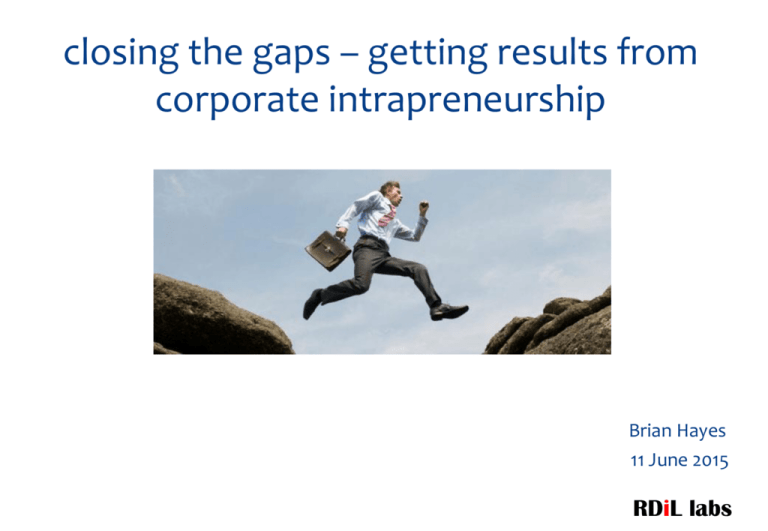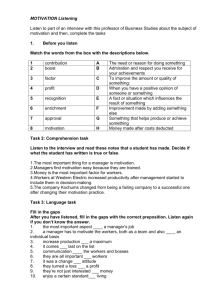Please click here to view the slideshow
advertisement

closing the gaps – getting results from corporate intrapreneurship Brian Hayes 11 June 2015 RDiL labs “High impact entrepreneurs – video” https://www.youtube.com/watch?v=SC8FdY6jMBA Source - Amy Wilkinson (lecturer/researcher at the Stanford Graduate School of Business - lessons from high impact entrepreuners) “Summary” Gaps – Opportunities others don’t see or address Horizon View – Manage speed and complexity with a vision Ooda Loop – Processes to Observe, Orient, Decide, Act Fail Wisely – Ways to learn with small bets and tests Network Minds – Harness brain power to build and solve Unleash generosity- Help others with small kindnesses BELIEVE you will create something BIG – Sense of DISCOMFORT – Takes COURAGE “so what’s the movie we are creating within our organisations” “it starts with culture – culture is where the ingredients of success are mixed – the “actors” playing their part” “The shadow of leadership” “that attract teams and partners to work together” “where there is urgency and a sense of purpose” “where priorities inspire action/execution” “do we treat our priorities like very ill patients” “where communication is really effective” “where people are empowered” “where the right metrics drive the right behaviors” “number of new products per business” “number of new partners that bring new capability” “number of replicated innovations from other industries or geographies” “number of new channels to market” “number of know-how or patents” “where wins are celebrated together” “where relevance and sustainability are a constant test” “relevant based on evidence” “strategic aligned” Citi's strategy is built around three secular global trends: Globalization—the increasing connectivity of all the world's nations, economies and markets; Urbanization—the concentration of people and GDP growth in cities; Digitization—the transformative power of technological innovations. Quote - Mike Corbat CEO Digitisation Portfolio Examples: •Digital Communication •Digital Consumption •Digital Products “and” “relevant based on being customer centric” “sustainable based on - knowing the gaps, prioritising the solutions and spending wisely” “prioritised gaps create the different storylines for the movie” “capability gaps” “gaps in the business model(s)” “generic strategic and tactical gaps” “strategic” “tactical” “industry observed gaps” The Music Industry Has 99 Problems. And They Are… Tuesday, September 2, 2014 by Paul Resnikoff Digital threat to investment banks “We should have revolutionised the way we approach our clients. Banks have fallen behind.” September 23, 2014 9:27 pm By Daniel Schäfer Closing the gap between education and industry Customer obsession gap According to a recent global study of 1,500 CEOs conducted by IBM, the biggest challenge those CEOs face is the so called complexity gap. Eight out of 10 expect the business environment to grow in complexity, but fewer than half feel prepared for the change. The research also reveals that CEOs see a lack of customer insight as their biggest deficit in managing complexity. They prioritize gaining customer insight far above other decision-related tasks and rank “customer obsession” as the most critical leadership trait.“ Source: An Anthropologist walks into a bar, Christian Madsbjerg and Mikkel B. Rasmussen, Harvard Business Review March 2014 “prioritise the gaps” “consider all strategic, tactical, capability, business model gaps – prioritise the ones that intersect all 3 circles” “research for facts, be wildly optimistic, be critical, explore lateral possibilities, note all emotions” “ll “the tools are the equipment that’s used to produce a really good movie” “assess what tools to use” Client centric maturity assessments cultural diagnostics Future enterprise models Design thinking Project Management “the vision is the eye of the director making sure the storyline is kept on track” “create visions that inspire” 1. Desirability 2. Feasibility 3. Commerciality “test relevance….with….stakeholders” “pill or vitamin” “to create customer centric portfolios” “use customer data to understand and segment your customers” “identify the best customers” “Customer centricity starts with a focus on high-value customer segments ” “the next big thing and the high-value segments should be connected” “solutions for the best customers” “each customer centric project is a scene in the film” “the labs are like the studios” “use labs to do research, manage complexity and connect with the buyers” Researching the horizon view Managing speed and complexity Rapid Prototyping and Testing Harnessing Network Brain Power - Engagement Centre “labs – can co-ordinate a range customer centric portfolios ” “customer centric portfolios go on a journey” “a good place to start is to…” “use a framework….. that works” So in summary…. •High Impact entrepreneurs – gaps, horizon view, have a process, fail wisely and use networks to deliver impact. •Deliver a customer centric experience (products, services and business model) to make your best customers even better – it starts with the CULTURE that drives behaviour (leadership, teamwork, good partnerships, urgency, prioritization and execution, effective communication, empowerment, the right metrics and celebrated wins) – leading to a focus on things that are really RELEVANT based on evidence (company strategically aligned and customer centric aligned) – things that are SUSTAINABLE to your business model based on the PRIORITISED remediation of gaps (capabilities, business model, strategic, tactical and other industry observed) to deliver impact. Develop customer centric portfolios focused on high value customer segments based on customers’ data. • Use labs and external networks to research themes, explore gaps, manage complexity, engage with customers and manage and prioritize projects. • Corporate intrapreneurship, change and innovation are inter-related – the prerequisites for effective execution are in our hands………… “The end…a perspective” Brian Hayes RDiL labs






